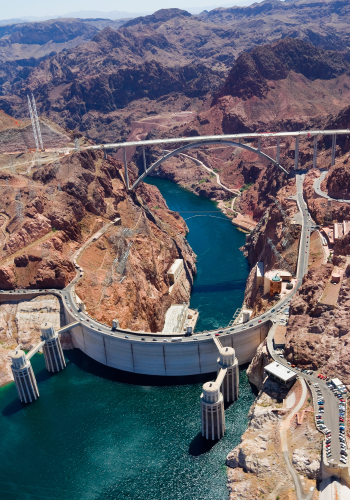


The main issues affecting water supply and sanitation in the US include water scarcity, pollution, a backlog of investment and concerns about the affordability of water for the poorest in its society. Experts say the unpredictability of rainfall as a result of climate change is expected to produce more severe droughts and flooding, with potentially serious consequences for water supply and pollution from combined sewer overflows. In particular droughts are likely to affect the 66% of Americans whose communities depend on surface water. For example, drought, as a result of climate change, is predicted to reduce river flows in the south western US, potentially affecting the drinking water supply of large cities such as Las Vegas, Phoenix and Los Angeles that depend on rivers for their primary supplies.
Water usage in the US is increasing year-on-year and many regions are feeling the pressure. It has been reported that at least 36 states are anticipating local, regional, or state-wide water shortages by 2013. Cities, utilities, state and federal governments have addressed these issues in various ways. To keep pace with demand from an increasing population, utilities traditionally have augmented supplies. However, faced with increasing costs and droughts, water conservation is beginning to receive more attention and is being supported through the federal WaterSense programme. The reuse of treated wastewater for non-potable use is also becoming increasingly common.
US President Barack Obama said that his mission would be to “reinvigorate the drinking water standards” and “restore better Federal financing for water and wastewater infrastructure…establishing policies to help high-growth regions with the challenges of managing their water supplies”. The President and his administration recognise the need to protect such natural assets as the Great Lakes and also the pressures facing the western States which will face serious water shortages if they are to meet their fast growing needs.
In the US there are two State Revolving Funds (SRFs) which play an important role in financing water and sanitation investments. The larger Clean Water State Revolving Fund, created in 1987, and the smaller Drinking Water State Revolving Fund, created in 1997, receive federal and state contributions and issue bonds. In turn, they provide soft loans to utilities in their respective states, with average interest rates at 2% for up to 20 years in the case of the Clean Water State Revolving Fund. In addition to the SRFs, the United States Department of Agriculture provides grants, loans and loan guarantees for water supply and sanitation in small communities.
It is clear that the Obama administration recognises the seriously deepening water supply situation, despite water at present not being viewed as a vote winner; it is after all primarily a State responsibility. However, President Obama and the White House are keen to offer financial support where necessary to the water industry. For example, in 2009, Tom Vilsack, the US Agriculture Secretary, announced almost $1 billion in rural water and environmental projects funded through the American Recovery and Reinvestment Act (ARRA). These projects, he says, will help provide safe drinking water and improved wastewater treatment for rural communities in 35 states. In February last year, Vilsack announced funding for a further 47 similar projects in 19 states.
“These investments in water and wastewater infrastructure will deliver safe drinking water and protect the quality of our environment,” Vilsack said. “A safe, reliable water supply is vital to economic growth and development. Through these projects, we are helping to achieve the Obama Administration's economic recovery goals to rebuild and revitalise the nation's infrastructure.”
Over the last two years, the US Federal Government increased clean water funding to States by over 70% from US$1.5 billion to US$4 billion through State Revolving Funding (SRF). The Department of the Interior's Interior Recovery Act – which was updated in May 2009 – will invest $945 million through Reclamation in selected projects that will bring water to rural communities and will stretch water supplies through reuse, recycling and water conservation. Funding will be invested in environmental and ecosystem restoration. Other funding will address the rehabilitation of aging infrastructure. Some of the money will be used for an emergency response to the devastating repercussions of the current drought in California.
The US Bureau of Reclamation, which was established in 1902 and is the largest wholesaler of water in the US, is best known for the dams, power plants, and canals it constructed in the west, including Hoover Dam on the Colorado River and Grand Coulee Dam on the Columbia River. It brings water to more than 31 million people, and provides one out of five Western US farmers with irrigation water for 10 million acres of farmland that produces 60% of the nation's vegetables and 25% of its fruits.
Michael L Connor, Reclamation's Commissioner at the US Department spoke earlier last year before the US House of Representative National Resources Committee. He said the President's Fiscal Year budget of US$1.1 billion for water and related resources was essential for the maintenance and improvement of services under its control and to “enable capability to increase available water supply for agricultural, municipal, industrial and environmental uses in the western United States”.
He since added: “The science is clear that climate change will add to the challenges we face today in managing our water supply, water quality, flood risks, wastewater, aquatic ecosystems, and energy production. The Department of the Interior started the WaterSMART Programme to achieve a sustainable water strategy to meet our Nation's water needs now and into the future.”
Through its Water and Environmental Programmes (WEP), the Department of Agriculture provides loans to small communities throughout the US to improve drinking water, sanitary sewer, solid waste and drainage facilities in rural areas.
Clean Water Act
US Congress passed the Clean Water Act in the mid 1960s when water systems in the USA were in serious trouble. The Act promised to restore and maintain the integrity of the country's waters and protect aquatic life. Four decades on, have things improved? By and large the answer is yes, however, according to Lisa P Jackson, head of the US EPA (Environment Protection Agency): “America's water bodies are imperilled as never before. Water quality and enforcement programmes face complex challenges, from nutrient loadings and stormwater runoff, to invasive species and drinking water contaminants.”
She maintains that these challenges demand both traditional and innovative strategies including watershed protection programmes for areas such as the Chesapeake Bay and Great Lakes, and measures to address post-construction runoff, water quality impairment from surface mining, and stronger drinking water protection.
Speaking earlier this year at the Clean Water Conference in Wisconsin, Ms Jackson said: “We recognise that clean water is vital to our health, to our environment, and to our economy. We know that if our waters are not safe for fishing and swimming, then our health, and the health of our children, is at dangerous risk for deadly conditions like cancer and neurological disorders.
“We have seen how failing to protect our lakes, rivers and streams leads to the loss of irreplaceable natural resources, destroys ecosystems and endangers species. And we know that if we neglect to take action, more beaches will close and more treasured tourist destinations will lose business…more communities will lose jobs and they will have less of what they need to attract new ones. We will be forced to spend money cleaning up pollution we might have prevented.”
In many area of the US, drought conditions and population growth have increasingly stressed water supplies and therefore water reclamation technology has been adopted. The city of Peoria, Arizona relies on both surface water and groundwater sources for its supply of potable water. To alleviate the decreasing water supply, the city decided that reclaimed wastewater was an underused resource and could be used for groundwater recharge and for non-potable uses such as irrigation, decorative water features and industrial purposes. The Peoria Butler Drive Water Reclamation Facility was built to expand the region's water reuse system and uses GE's advanced membrane bioreactor (MBR) technology.
Steve Watzeck, strategy development leader and chief marketing officer, water and process technologies at GE Power & Water in the US said: “The United Nations predicts that two-thirds of the world's population will face water scarcity issues by 2025. Therefore, water reuse will be increasingly critical in making the most of the world's freshwater resources. It involves investing in the necessary infrastructure and adopting policies to support increased wastewater treatment and the usage of high-quality recycled water in industrial processes, for crop or landscape irrigation, and other applications.
“GE believes that adopting reuse and wastewater treatment practices can help countries create sustainable water supplies while allowing continued economic development. Many reuse projects are already in place or are being implemented around the world. We see a growing demand for our water process technologies and services by an ever-expanding array of municipal and industrial customers, including municipal treatment plant operators, energy producers, mining operations and various commercial manufacturing operations ranging from computer chip manufacturers to food producers.”
Desalination continues to play a large part in the provision of water throughout the coastal US states and an example of this is the work carried out by Poseidon Resources Corporation. The company offers custom solutions to local governments and businesses by developing, investing in and managing high quality water treatment and water supply facilities throughout North America. One of the company's current projects is the Orange County Huntington Beach facility which will provide 50 million gallons of clean water per day, at no cost to the taxpayer.
Working together with local and state agencies on this project, Poseidon Resources Corporation will hopefully begin construction next year, with the facility possibly operational in 2013.
Additional information
WaterSense
Launched in 2006, the USA's WaterSense programme is an EPA-sponsored partnership that seeks to protect the future of the country's water supply through promotion of water efficiency while enhancing the market for water-efficient products and practices.
The programme brings together local water utilities, the state governments, product manufacturers, retailers and consumers. Consumers are encouraged and helped to make water-efficient choices, including differentiating between products and services in the marketplace and adopting simple daily activities which reduce water use. It also encourages companies to be innovative in design and manufacture of their products.
Clean Water Act
‘Considering the Clean Water Act’ was a conference convened by the Water Environment Federation and the Nicholas Institute for Environmental Policy Solutions.
A report following the conference in October 2009 concluded that US administration at local and national level recognise that climate change will affect all uses of water, including agriculture, the urban environment, wildlife, drinking water supply and more, and that it will alter precipitation patterns, alter stream morphology, increase wet weather pollution in some areas, and add stress due to declining water levels in others.
It recognised that the climatic impacts on water resources may be among the earliest effects experienced and may necessitate redesign of many water and wastewater facilities and impose unquantifiable stresses on water resources.
It suggested that: “Addressing climate change will also require innovative and flexible approaches that go beyond the current prescriptive approach. An innovative and flexible approach may open the door to try new methods in water management aimed at building resiliency.” And that: “Major and comprehensive Clean Water Act reform was required, occurring in stages, addressing short-term fixes first and progressing toward long-term solutions.”
Regardless of the timing and sequencing of reform, a new and strengthened regulatory system must identify a “Comprehensive institutional framework that delineates political jurisdiction; incentives and momentum for innovation; verification of what works and why; and recognition of the dynamic nature of water resources in moving toward a regulatory regime that supports the natural hydrology.”





